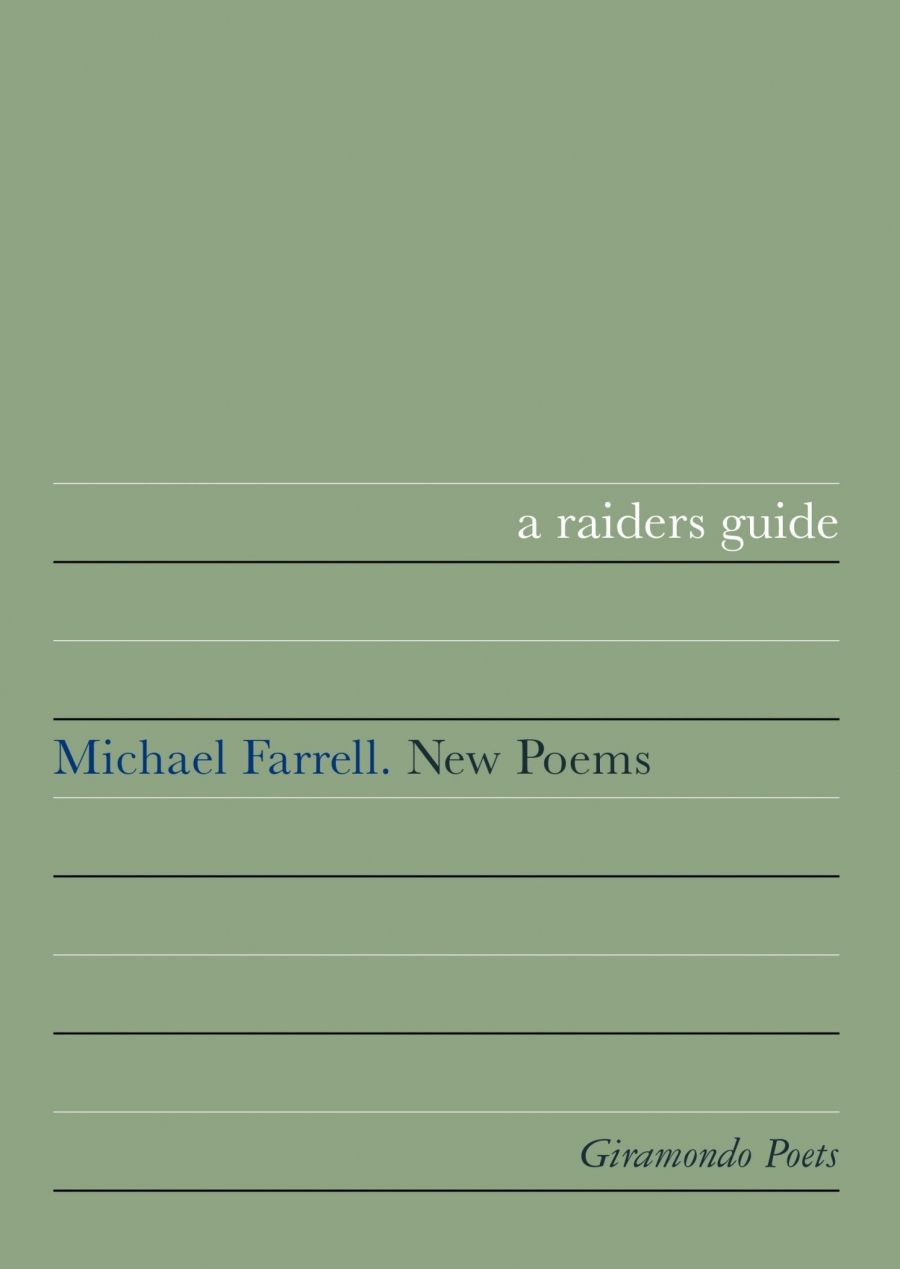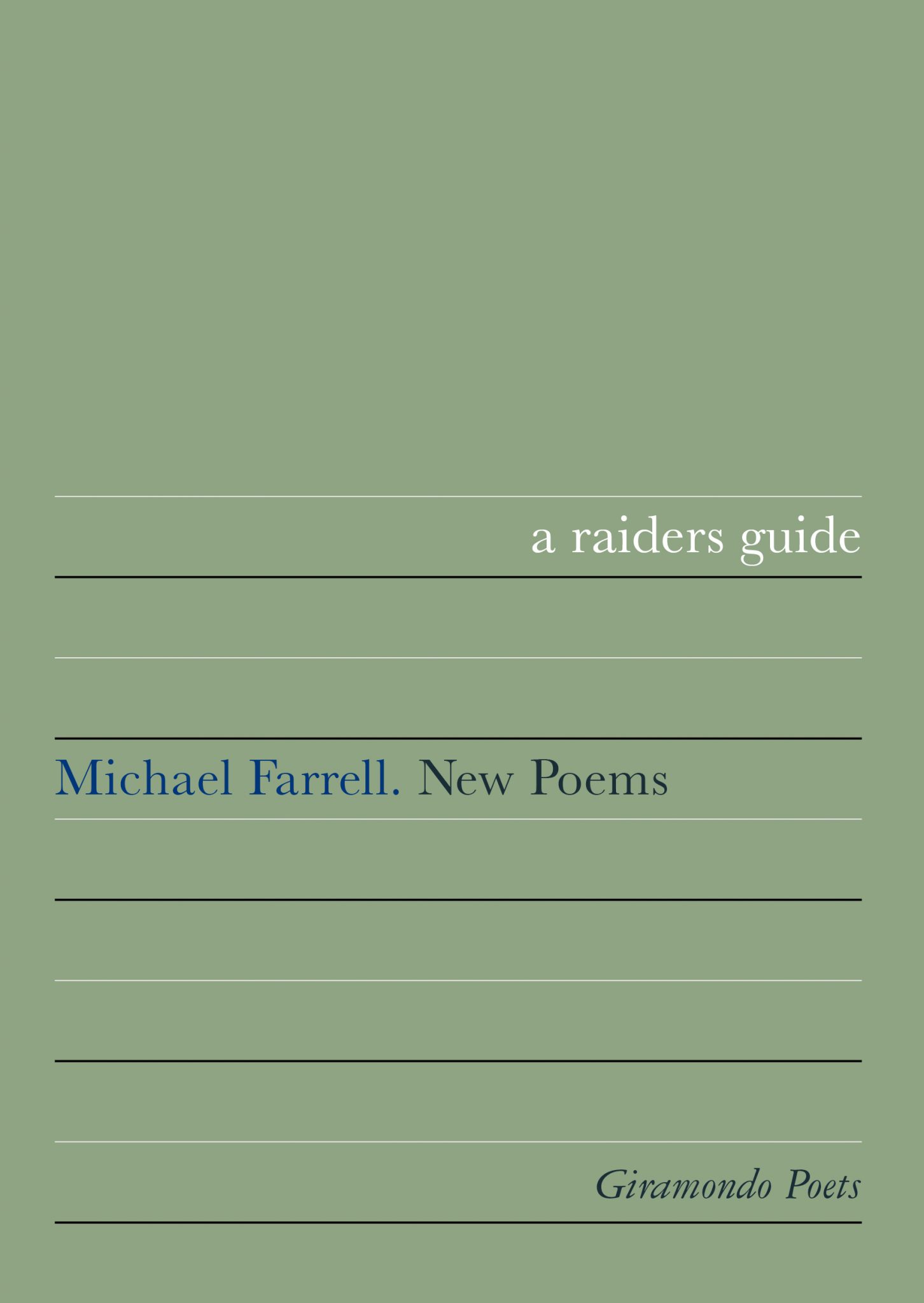
- Free Article: No
- Contents Category: Poetry
- Review Article: Yes
- Article Title: ‘In the scarlet whatever’
- Online Only: No
- Custom Highlight Text:
Michael Farrell’s a raiders guide has no page numbers and no index, indicating that it is to be read as one. Farrell’s work, like that of the Language poets, draws attention to language itself rather than emphasising content or emotion: that is, language is at least temporarily estranged from meaning. Yet, like most attempted definitions, the same could be said of most poetry. Farrell’s work follows in a line from Mallarmé, some Futurist and Dadaist poets, Gertrude Stein and James Joyce, and more recent Language poets such as Ron Silliman and Bob Perelman. While another Melbourne ‘experimental’ poet, ΠO, often emphasises through vocal performance the component parts of words, Farrell illustrates this visually, often using some self-imposed constraint that calls for repeating lines and words that, in turn, break up until poems almost bubble into a centrifugal chaos. As in the language of text messaging, abbreviated words are nevertheless usually clear.
- Book 1 Title: a raiders guide
- Book 1 Biblio: Giramondo, $22 pb, 96 pp
- Book 1 Cover Small (400 x 600):

- Book 1 Cover (800 x 1200):

There is a symmetry to this book. It opens with a long prose piece, ‘sprinter’, which Farrell calls a response to Alison Croggon’s book The Blue Gate (1997). Often wittily, it seems to presage the poet’s trek in a raiders guide, the tone swinging from tremulously precious to world-weary, as these lines show:
Wilde, Borges, Foucault – a pie I foil and carry. Orphaned by god, I become the sunlight on the gate (that I interrupt), the moth asleep (that I wake). Suffering for belief has many forms: all traps. What have I added to my cv since ’75, since 9 o’clock? …
Will I wake up Australian? Will I save anything? Cool any flame? The flowers tremble in their heresy …
The past’s always now – in the scarlet whatever …
You think I can’t stick Marx to this? …
What was once pseudo is orthodox …(‘sprinter’)
The last work is a prose piece that responds to John Kinsella’s The Hunt (1998). New work is created by raiding the past, although neither Croggon nor Kinsella is identifiable in these works. Farrell overtly and consciously pursues what’s usually innate in poetry, and remixes, samples and shuffles the works of others – ‘A bit of past reglued, retouched … Humans can’t help adding levels, becoming replicas of what they enter’ (‘sumumn’).
Farrell’s poetry is often strings of aphorisms and non sequiturs where meaning comes like an after-image. Words are squashed together or split at unexpected points as in ‘pornwithostrich es’: ‘hislivingfeathery / lan gu age walkinginhanging out / wait // ingforthemuse um / heygoin / wardsbehum / ble blowmy / clairvoyance / money some /wheretorest-working …’ This is highly entertaining but resistant work; readers must often employ their own predictive text to fill in missing letters and words.
The poems ‘broken hills’ and ‘pmt x 3’ apparently respond to Laurie Duggan’s Blue Hills sequence and to the Dorothy Porter poem ‘pmt’, but Farrell’s inclusion of French, Italian and other foreign words and phrases in this section of the book seems an unnecessary obfuscation or embellishment. Also, what a poem responds to cannot explain the poem. In Farrell’s first book, ode ode (2002), capital letters and punctuation were dropped, and he employed methods based on – literally – a throw of the dice. Here, some poems merge the words together to be interpreted like a Sumerian tablet. Poems such as ‘cryinglikeawreckingmach ine’ and ‘letlovebeyourguide’ end with lists of numbered lines which are to be inserted in the poem; what we have just read proves to be only half the poem. At other times, as in ‘black bear anthology piece’, asterisks indicate where alternative lines listed at the end of the poem can go.
‘Fathers’, ‘sons’ and ‘swallows’ are some of the recurring words in this volume, and it is this ghostly trinity of canon, response, synthesis that Farrell’s a raiders guide enacts. He mashes up influences – ‘the desire to be prior’ – bookending contemporaries Croggon and Kinsella like archetypes of gender, like siblings, positioning his work. ‘realm of humour’ and ‘ine / legant pithy’ are poems about the various sorts of poetry one may write. Each experiment illustrates a type of poem, including some neatly lyrical works, ‘flashback #7’ and ‘formal x’, a love poem. The four shorter prose poems – ‘now or nefertiti’, ‘the snow depardieu’, ‘the blue pertains’ and ‘for the bourgeoisie’ – repeat phrases and sentences that sever and reform so that the end circles back, slightly changed, from its beginning. a raiders guide is also a type of Pilgrim’s Progress: ‘Do your worst. Icon pursues icon for its aesthetics. But there’s more! (The rhetoricians want it.) They face each other in cinematic illusion …’ (‘sumumn’). The longer prose pieces are the easiest to read – and to quote – and Farrell’s peculiarly amusing playfulness is the most consistent tone, killing any expected gesture, throttling any cliché. Farrell’s original linguistic inventions join those of ΠO as well as Ania Walwicz, and also Jennifer Maiden’s ‘cluster’ poems, John Tranter’s ‘terminals’, Chris Edwards’s A Fluke: A Mistranslation of Stéphane Mallarmé’s Un coup de dés, Javant Biarujia’s taneraic language, Alex Skovron’s sonnetinas and Ouyang Yu’s Chinese-Australian puns, among others.


Comments powered by CComment